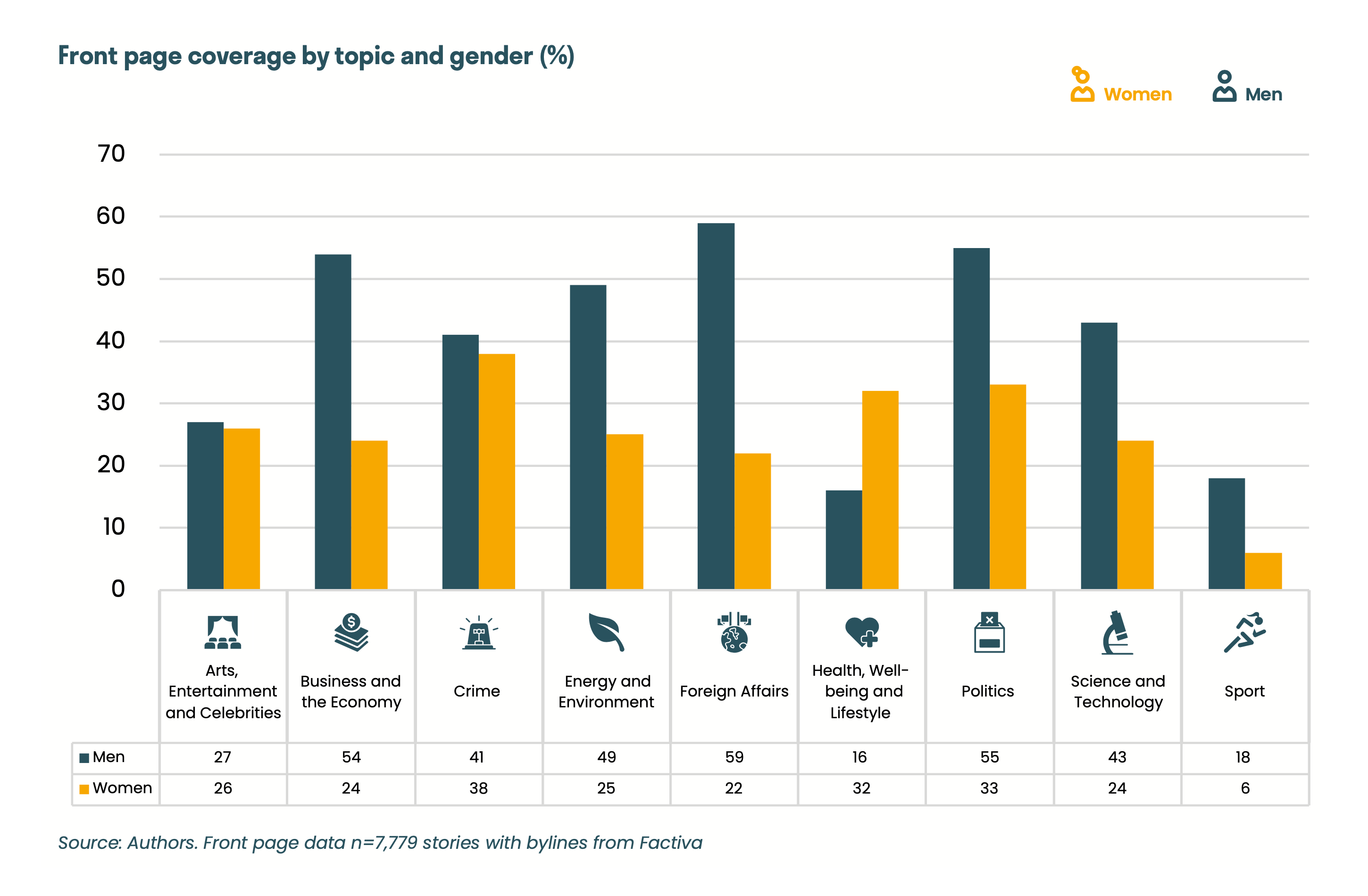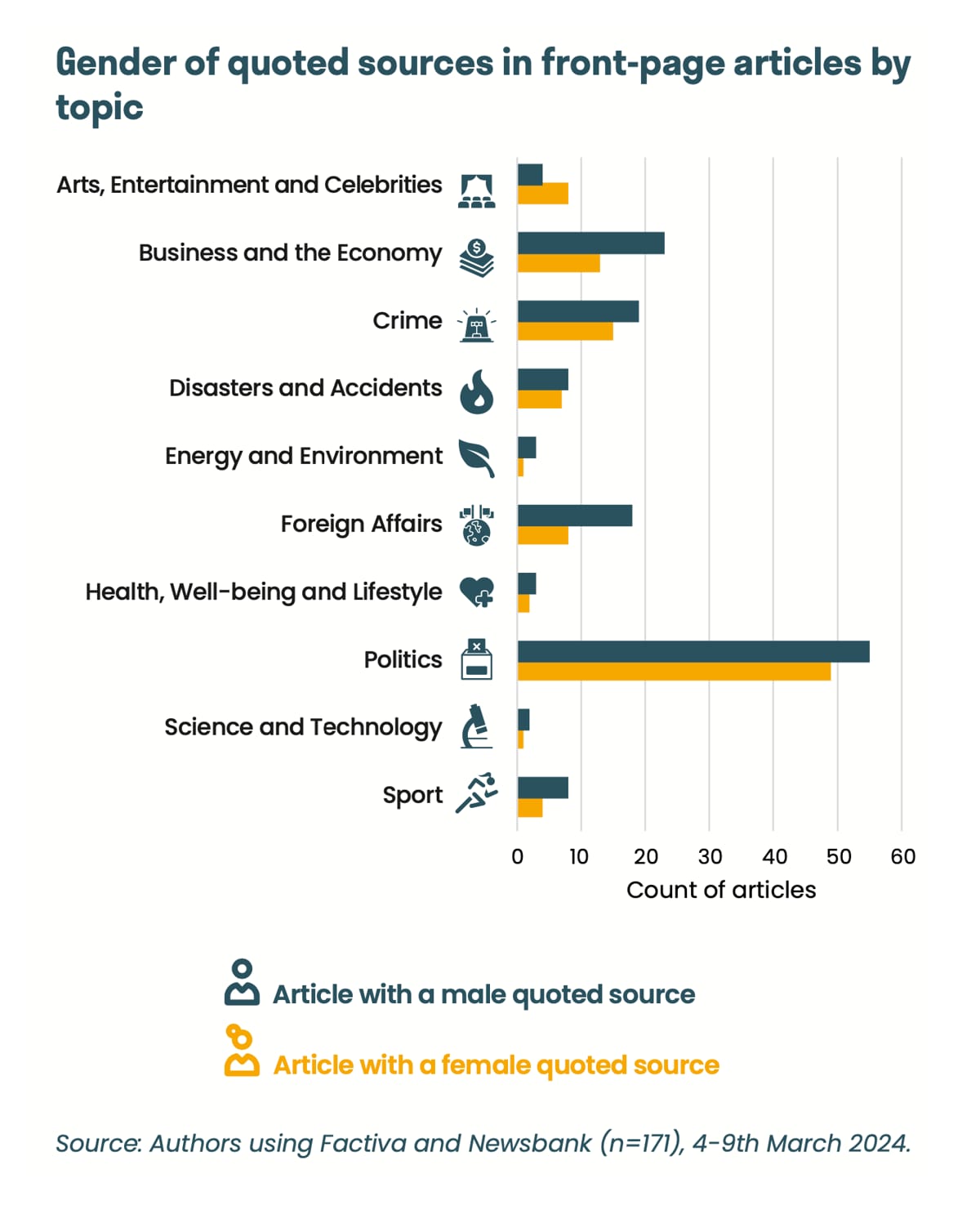The latest findings from Australia’s largest-ever study on the representation of women in the media exposes a persistent gender gap – one that affects both who reports on the top stories of the day and who gets quoted in them.
The sixth edition of the Women for Media report identifies foreign affairs and international security as one area where men dominate news and opinion coverage.
Across the news landscape – radio, print, online, and TV – men account for 60 per cent of foreign affairs reportage. The study, which brings together political scientists and media scholars, reveals that the gender divide is most pronounced in front-page foreign affairs stories and opinion articles.
Men write 73 per cent of these articles – 13 points higher than the overall share of male bylines across all front-page stories. The gap expands even further on the opinion pages, where men account for a staggering 86 per cent of contributors on these issues – 15 points higher than the share of male bylines in all opinion pieces.
While the report is uncomfortable reading for editors and journalists trying to narrow the gender gap, the findings are not surprising and remain consistent with past studies. Since 2012, when the Women Leadership Institute Australia (WLIA) founded the series, “hard news” areas, such as foreign affairs, have remained overwhelmingly male-dominated.
In comparison, women are over represented in “soft news” such as stories on well-being, lifestyle, celebrity and the arts.

The 2024 report is based on an analysis of over 200,000 news stories across print, broadcast and online news from April 2023 to March 2024, with deeper dives in to front page and opinion page coverage of Australia’s 30 top news outlets during March 2024. It uses both computational and manual coding to combine these different data sources with expert interviews with editors. Together, the report captures women’s representation in the media, both as producers of news and as expert sources.
It finds gender inequality remains prevalent in Australian news media, despite the similar numbers of male (2,604) and female journalists (2,423) in the year’s sample. Tabloids, with their focus on crime, disasters, and lifestyle, feature more women bylines in these areas. In contrast, broadsheets, covering business and foreign affairs, are predominantly male authored.
During the study period, opinion pieces on foreign relations were exclusively written by men in three publications: The Sydney Morning Herald, News Corp’s Courier-Mail, and its tabloid, the Adelaide Advertiser.
This disparity extends to the representation of quoted sources and the perception of who is considered as expert. In areas already male dominated with expert commentary such as diplomacy and foreign affairs, this is a problem because it means that as a society the public get a narrower perspective of world views than what they otherwise might if women and others’ perspectives were regularly included in the news mix. In other words, consistent gender bias in foreign affairs normalises male perspectives.
“The unfortunate reality is that women’s perspectives are being overshadowed, as men’s voices and images continue to dominate the media landscape. The result is that we all miss out on ideas and solutions that benefit everyone,” says WLIA chair, and report founder, Carol Schwartz.

Second to politics, “foreign affairs and international security” was the next most popular subject area for commissioning opinion articles in the Australian media. While there are indications that the gender gap in political coverage has narrowed, the same is not true for foreign affairs. Of the ten topics studied, the gender gap was largest overall for foreign affairs coverage, especially in the opinion pages.
But results were mixed across mastheads. During the study period, opinion pieces on foreign relations were exclusively written by men in three publications: The Sydney Morning Herald, News Corp’s Courier-Mail, and its tabloid, the Adelaide Advertiser. While still falling short of gender equality across its opinion bylines, the Australian Financial Review had made some efforts to include perspectives from both in-house and external women on international politics.
“I think gender balance in opinion is a big challenge,” Australian Financial Review editor Cosimar Marriner told the study authors. “I really think it requires extreme focus to make it happen. It is one of my biggest challenges because it’s so visible, it gets brought up by everyone and I see it every day when I look on our website.”
On the other end of the spectrum, the Canberra Times was the only publication in which women exclusively authored opinion articles discussing foreign relations, during the time of analysis.
The gender gap in foreign affairs reporting also persists in journalists’ choices of quoted sources, with journalists profiling men’s opinions (and not women’s) seven times out of ten. While certain news events, such as a story involving a male prime minister, will influence who is quoted and when, the data still reveals that men journalists are more likely to quote male sources compared to their women colleagues who quote women sources more frequently.
This suggests that some journalistic discretion is exercised and that the gender gap in foreign affairs reporting will not narrow unless reporters and editors make conscious efforts to overcome gender bias in their coverage when they have discretion to do so.
“There is no doubt that media organisations are facing tough times, with business models under pressure, increasing news avoidance, and the rise of disinformation on social media,” says Schwartz.
“Despite these challenges, it is crucial that we continue to prioritise diverse voices in our news coverage. The stories we see, the voices we consider authoritative, and the narratives we embrace all determine the future we build.”
The full report is available here: An Unfinished Story: Understanding Gender Bias in Australian Newsrooms.

